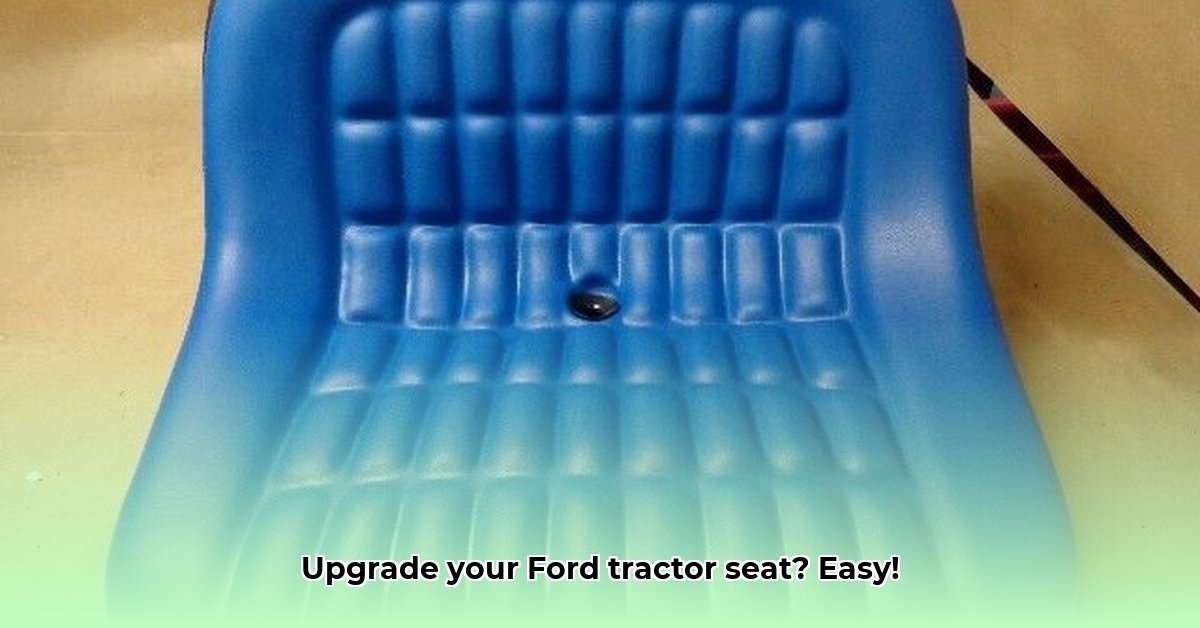
Replacing your Ford tractor seat can significantly improve comfort and productivity. This comprehensive guide provides step-by-step instructions to make the process smoother and less daunting. A comfortable and properly functioning seat is crucial for long workdays, minimizing fatigue and improving overall operator well-being. For similar tractor seat replacements, check out these other options.
Identifying Your Tractor Seat: The Crucial First Step
Before purchasing a replacement, accurately identifying your tractor's seat model is paramount. Why? Ford tractors used various seats across models and years, and an incorrect replacement leads to wasted time and effort.
First, consult your tractor's owner's manual. This contains the seat's part number—essential for accurate ordering. If you can't locate your manual, carefully examine the seat itself. Look for labels, numbers, or markings often found underneath or on the sides. Take multiple clear photos, detailing the seat's unique features and especially the mounting bracket. If you're still uncertain, contact your local Ford tractor dealer's parts department. They possess the expertise and parts catalogs to help precisely identify the right replacement.
Choosing a Replacement Seat: Budget and Features
Once you've identified your seat, decide between an Original Equipment Manufacturer (OEM) part or an aftermarket option. OEM parts, sourced directly from Ford or an authorized dealer, guarantee a perfect fit but are generally more expensive. Aftermarket seats offer more variety and often lower prices, yet compatibility isn't always guaranteed. Always verify specifications before purchasing, paying close attention to dimensions and mounting points.
Consider your budget and needs:
- Basic Pan Seats: These budget-friendly options provide fundamental comfort and are generally easy to install.
- Suspension Seats: Offering superior comfort, these seats absorb bumps and vibrations, dramatically improving long workdays.
Here's a comparison:
| Feature | Basic Pan Seat | Suspension Seat |
|---|---|---|
| Cost | Lower | Higher |
| Comfort | Basic | Superior; Shock Absorption |
| Adjustability | Limited | Extensive (height, weight) |
| Durability | Varies by manufacturer | Generally More Durable |
Tools and Materials: Assembling Your Toolkit
Gathering the necessary tools before starting ensures a smooth and safe replacement. You'll need:
- Various sized wrenches
- Sockets (to match bolt sizes)
- Phillips and flathead screwdrivers
- Pliers
- A ratchet
- Safety glasses
- Work gloves
- Shop rags (for cleanup)
- New seat mounting bolts (if needed)
Having a helper to lift the seat is highly recommended, as tractor seats can be quite heavy.
Step-by-Step: Removing the Old Seat
Safety First! Always disconnect the tractor's battery (negative terminal) before beginning any work to prevent electrical shocks.
- Disconnect Electrical Connections: Carefully unplug any electrical connections (heaters, sensors) attached to the seat. Photograph the connections prior to disconnection for accurate reassembly.
- Remove Mounting Bolts: Using the appropriate wrenches and sockets, systematically remove the bolts securing the seat to the tractor's frame. Work carefully to avoid damage.
- Lift Out the Old Seat: With assistance, carefully lift and remove the old seat, being mindful of any remaining cables or connectors.
Step-by-Step: Installing the New Seat
- Align the New Seat: Carefully position the new seat onto its mounting points, ensuring precise alignment.
- Attach the Seat Securely: Use the appropriate bolts to fasten the seat to the tractor frame. Tighten the bolts evenly and to the manufacturer's specifications.
- Reconnect Electrical Connections: Reconnect all electrical components, referring to the photographs taken earlier.
- Test and Inspect: Test all seat adjustments to ensure proper functionality. Reconnect the battery.
Troubleshooting Common Problems
Even experienced individuals can encounter issues. Here are some common problems and their solutions:
- Incorrect Bolt Placement: Double-check bolt locations against diagrams in your tractor’s manual or the seat's instructions.
- Mismatched Mounting Brackets: This indicates incompatibility. Verify the replacement seat is correct for your tractor model.
- Electrical Faults: Carefully check all wiring and connections for any loose or damaged wires.
- Seat Doesn't Adjust: Examine the adjustment mechanisms for any obstructions or malfunctions.
If problems persist, consult your tractor's manual, contact a Ford dealer, or seek assistance from a qualified mechanic.
Conclusion: Back in the Driver's Seat (in Comfort!)
Replacing your Ford tractor seat is a manageable task with the right approach. By following these steps and prioritizing safety, you'll enjoy a more comfortable and productive experience in the field. Remember, regular maintenance, including cleaning and lubrication, will extend your new seat's lifespan. Investing in a comfortable seat is an investment in your well-being and productivity.